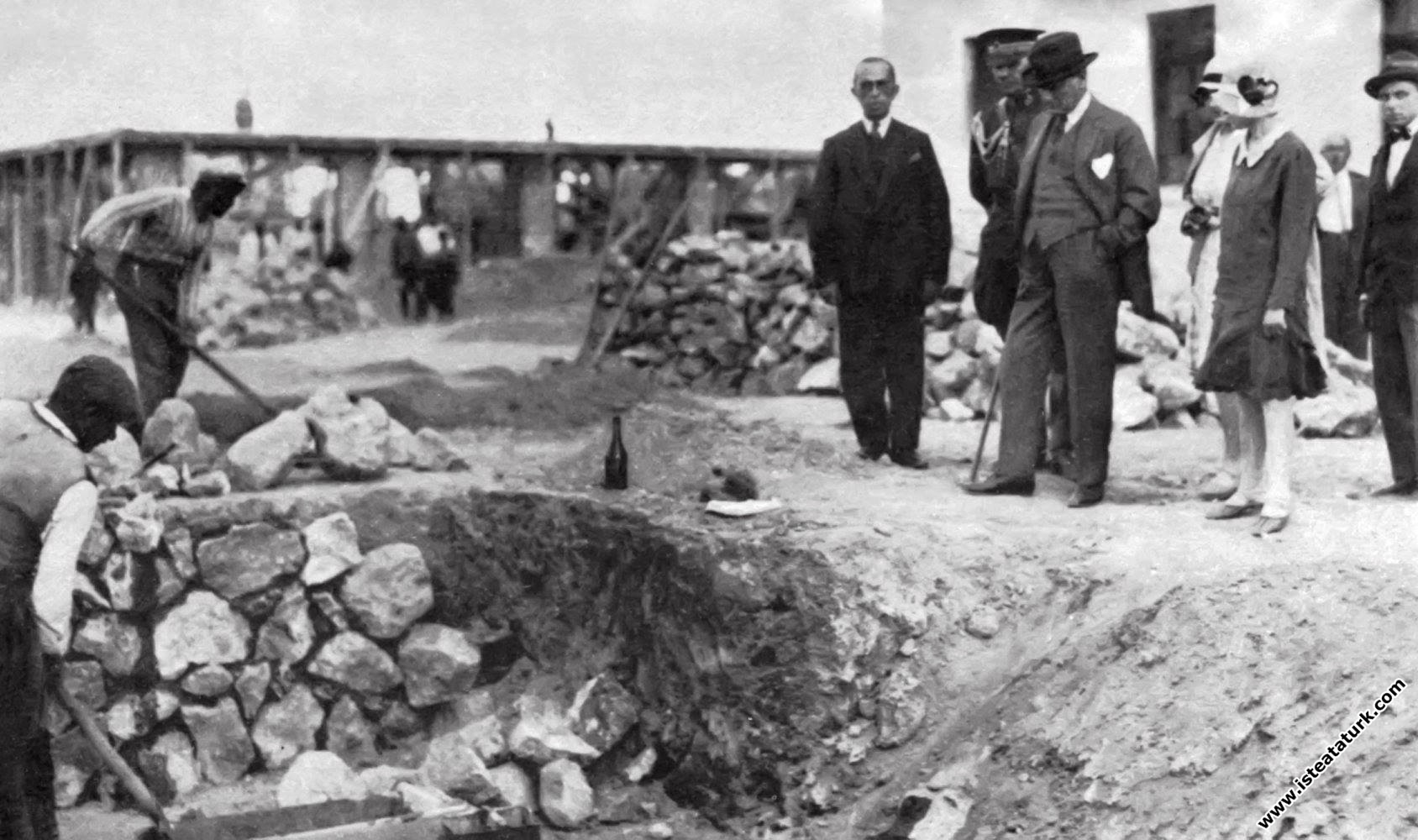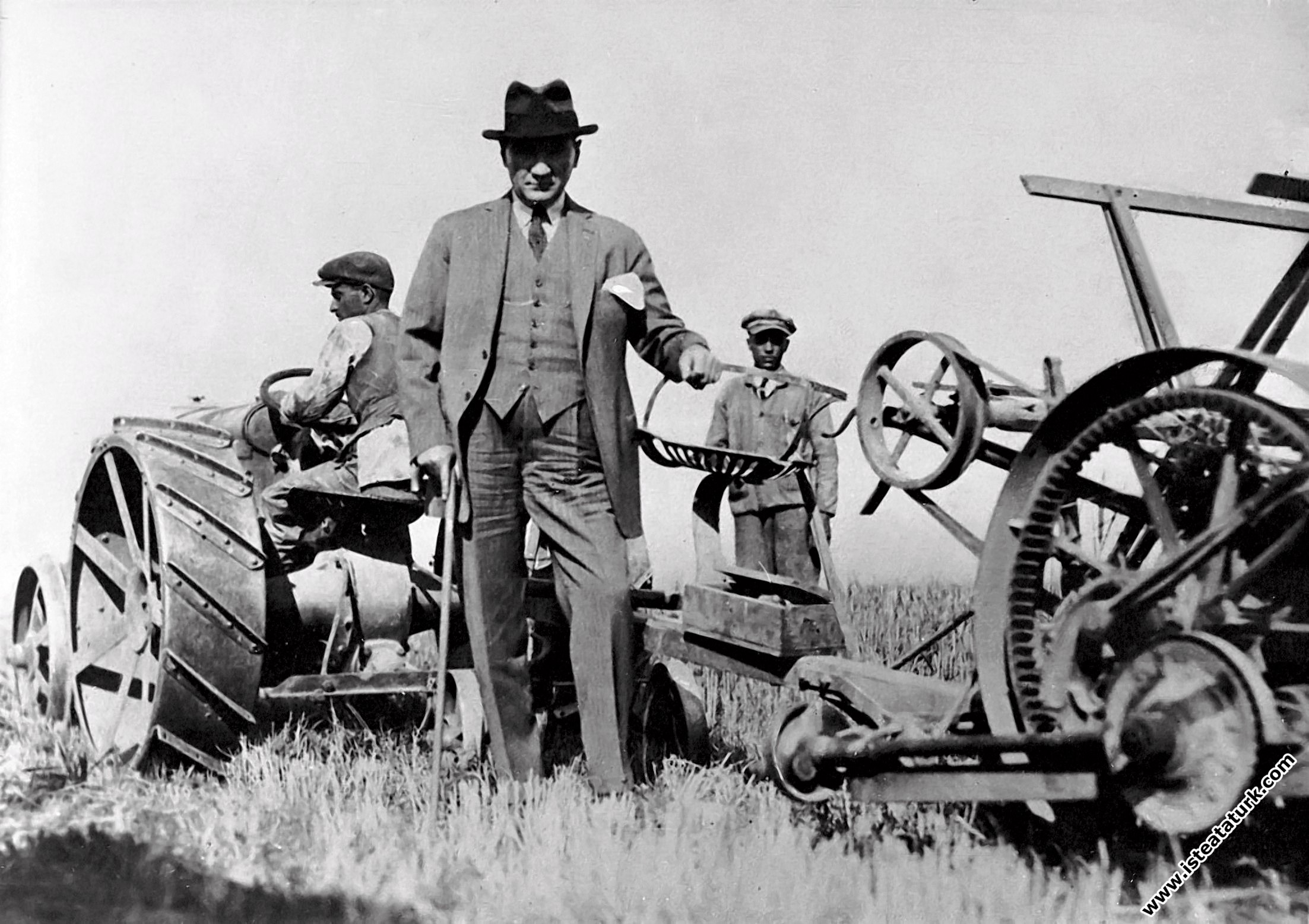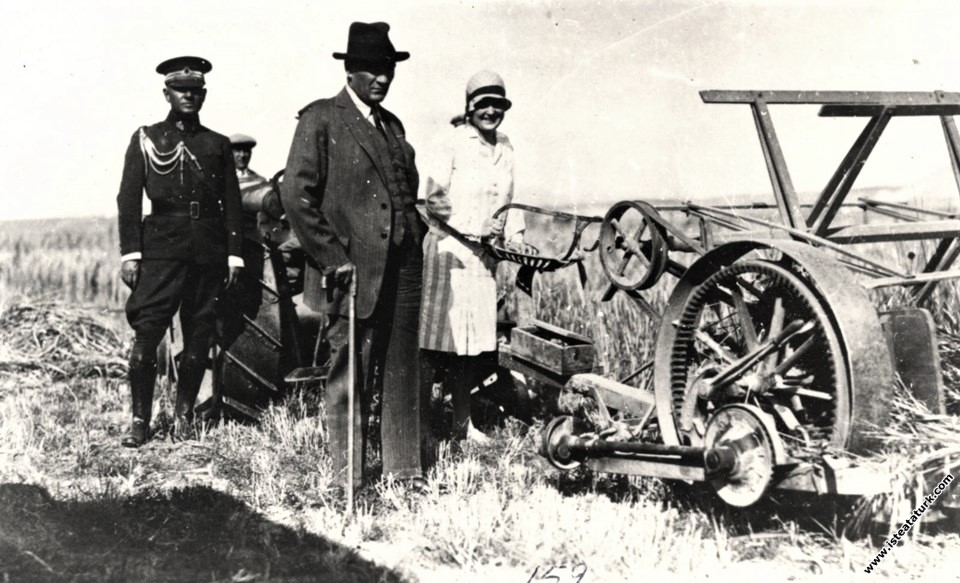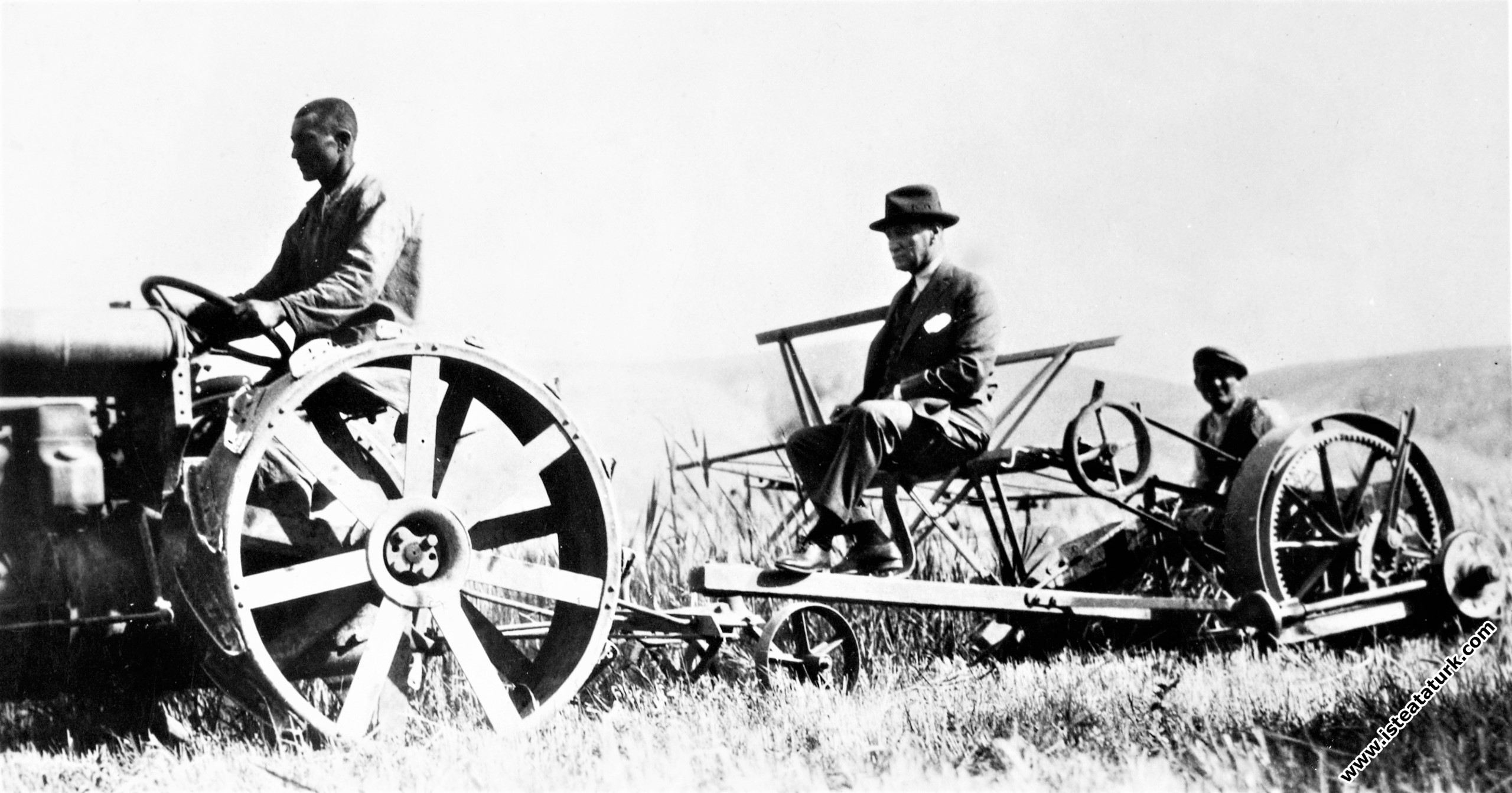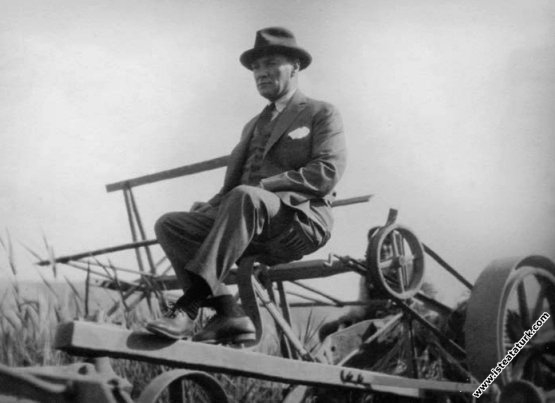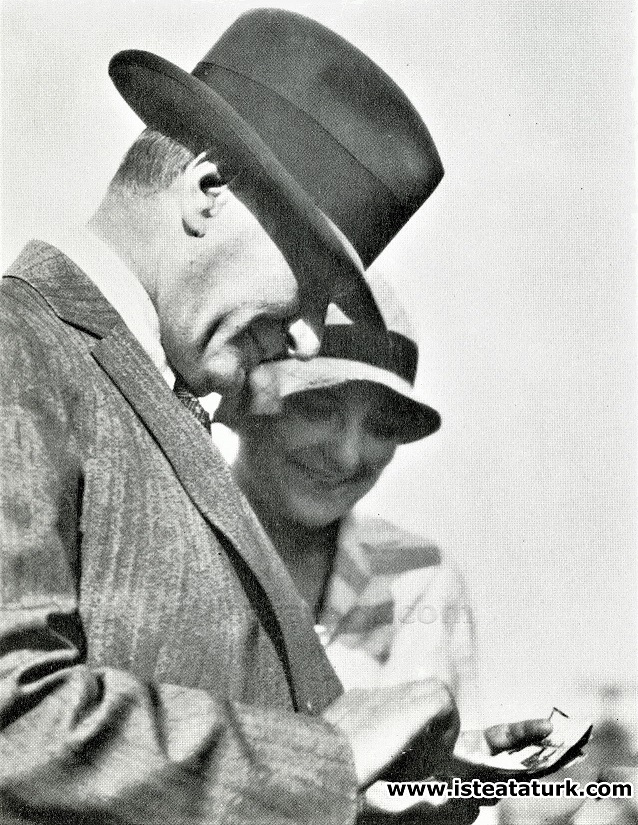Ankara, Etimesgut Village while being built. (04.07.1929)
| Photo source: Atatürk Gazi Mustafa Kemal, Photo by Cemal Işıksel, Turkish Historical Society Press, Ankara, 1969. Page:44 |
| Photographer: Cemal Işıksel |
Ankara, Etimesgut Village while being built. (July 4, 1929)
Asaf İlbay Tells; In Etimesgut Village
Etimesgut village was established and Rumelian immigrants were settled here.
One day, Gazi and I came to this village with him to examine some of the installations of the private building. The villagers and women surrounded the big man, they got into trouble. In their early seventies, a grandmother said:
-"Pasha Efendi, this is the habit: You need a place to put your cattle and other things next to the village houses. Even if the threshing areas are a little far away, it will not hurt. There is no place, thank God, plenty of land has been given. Order them to allocate these places for us."
Gazi gave the necessary orders to the relevant people and approached this great-grandmother. He stroked her hair and face covered with a thick Yemeni and said:
"Beautiful grandmother, open your bright face and let the sun shine. Besides, this thick cover is not healthy."
The old peasant woman took off the thick cloth covering her face and hair:
"You are the father of the nation, it is not forbidden for you. Come, let me kiss your beautiful face," he said, kissing Atatürk, crying and making us cry too.
Source: Atatürk's Private Life, Asaf İlbay, Tan Newspaper, 08.06.1940
Atatürk's Arrival in Etimesgut
On the morning of 29.11.1937, a polyclinic was again held in the hospital, and in the afternoon, as usual, they were getting ready to go to a village that was designated that day. The villages were shared among the nurses, and the nurse of that village had placed the envelopes of the whole village in specially prepared wooden boxes. He was distinguished by the small colored clips attached to the envelopes, called cavalry, on the receipts of those with some serious illnesses. The visiting nurse would take these cavalry envelopes, even if the patient did not come to the polyclinic established in that village, they would find it at home, observe the latest situation, and record the necessary information. Each of these envelopes belonged to a family, and all the personal and family histories of all members of the house were written in full, as well as all kinds of health records. In such village visits, the polyclinic was opened either in the village room or at the school, and all patients were treated. If I remember correctly, the blue ones marked tuberculosis, the red ones marked syphilis, and the yellow ones marked pregnant women. The midwife would go from house to house in that village by choosing the pregnant slip envelopes, checking the pregnant women and recording them by making the necessary measurements. Another nurse would stay with my father in the polyclinic established in the village and help him. Examinations were often done in a school or village room. On my holidays, I used to get in the car and go with them. In a short time, that tiny room would fill up, its air would become terribly heavy, and there would be no room for breathing from the smell of sweat emanating from sparsely washed body and frequently soiled clothes. He made the necessary measurements and recorded them. Another nurse would stay with my father in the polyclinic established in the village and help him. Examinations were often done in a school or village room. On my holidays, I used to get in the car and go with them. In a short time, that tiny room would fill up, its air would become terribly heavy, and there would be no room for breathing from the smell of sweat emanating from sparsely washed body and frequently soiled clothes. He made the necessary measurements and recorded them. Another nurse would stay with my father in the polyclinic established in the village and help him. Examinations were often done in a school or village room. On my holidays, I used to get in the car and go with them. In a short time, that tiny room would fill up, its air would become terribly heavy, and there would be no room for breathing from the smell of sweat emanating from sparsely washed body and frequently soiled clothes.
On that day, just as we were going to a village, four or five black limousines were seen coming from the opposite side, mixing the dust with smoke. After the people who got out of it held all the doors, this time Atatürk got out of one of the cars and went inside with my father. After taking a tour of the hospital, he immediately grasped what was told with his superior intelligence in a maximum of fifteen minutes, and the job was done. After that, he only went through the countries that my father had seen on his way back from America, answering the questions asked by him, and listened to what he told with great interest. Then he wrote the following lines in my father's diary.
"I visited the Etimesgut Health Center, I was very pleased with the information and explanation given by its esteemed director, C. Or. I saw with the conviction that his modern studies would yield good results. "
K. Ataturk
March 21, 2003, Professor Dr. Ahmet Nur OR* (son of Dr. Cemalettin Or)
* He was born on 17 November 1929 in Vize district of Kırklareli. He completed primary school at Etimesgut Primary School. After graduating from Ankara College, he graduated from Ankara University Faculty of Medicine in 1953. After completing his military service, he became an Assistant Doctor in 1955. He became a dermatologist and venerologist in 1959. He became Associate Professor in 1962 and Professor in 1971 in England. He worked in university hospitals in America and England. He is married and has two children and still resides in Ankara Balgat.
Source: Atatürk and Etimesgut, Ankara Chamber of Commerce Publications, Ankara 2003
Etimesgut
The origin of the name Etimesgut; The sample township, which was established because the first settlement was close to Ahi Mesud Farm, was named with this name. The township of Ahi Mesud, whose name was changed to "Etimesut" on August 2, 1930, was accepted as "Etimesgut" on December 24, 1937, based on the name that Supreme Leader Atatürk stated in his diary book during his visit to the Numune Health Center on November 29, 1937. Etimesgut, which has become an exemplary settlement with the close attention of the supreme leader, has come to be known with this name as an expression of respect for him.
The model township, which was started to be established on 28 May 1928, has become a truly exemplary settlement in the two years that have passed. What has been done has turned the township into a center of interest in the surrounding area. Etimesgut, a modern settlement clad in greenery in the middle of the steppe, is an example of what the young Republic thought and realized. This place is a source of inspiration for many more works to be done.
Selahattin Kandemir, one of the writers describing the exemplary township, introduces Etimesgut before 1932 in his work called Turkey Travel Book-Ankara Vilayeti:
"For a passenger who comes to Ankara for the first time, the bare land where the railway passes after Eskişehir does not give a good impression of this region. But when he arrives at Eti Mesut station, the landscape suddenly changes. A brand new village amazes people. This is the western gate of Ankara today. And every passenger, passing through this wide and high gate, bows once again in front of the great works of the Republican generation. A green field appears around new constructions, houses, school, government office, state, station, etc. (Kandemir, 1932)
Ernest Mamboury, on the other hand, describes the sample village in his book Guide Touristiqe (1933). "The model village Eti Mesud stands out with its charming houses located on the northern slope of the hills surrounding the fertile Engürü plain. While traversing the plain, irrigation works started to irrigate and regulate these large lands that had been neglected in the past. This exemplary village is among the achievements of the innovative spirit of the Republic. Everything is modern here. ; residences, stables, new buildings, cultural buildings, etc."
Why Was the Example Village Established?
In the years following the War of Independence, poverty and fatigue prevailed in Etimesgut, as in many parts of our country. It is a village where the young population died in wars, the land was neglected, diseases spread, and it remained in swamps. The fate of this village will change in the hands of Atatürk, just like the fate of our country, and the long-standing desolation will leave its place to hope and joy. In the following lines, we will read how the belief of our great leader to reach the ideal of "going above the contemporary civilization" for future generations turned into reality in Etimesgut.
Ideas underlying the establishment of an exemplary village:
The Republican administration, especially Atatürk, adopting the approach that the way to bring the Turkish Nation to the level of contemporary civilization is through economic independence; has chosen the path of mobilizing the existing economic resources of the country in an environment of internal and external peace by ensuring security and security at home. Therefore, in the period of 1923-1929, special attention was given to the development of agriculture, which is the most important and even the only source of wealth in the Turkish economy (Kayıran, 1988).
Atatürk wanted to create a developed and prosperous country in all aspects. The village and, accordingly, the agricultural development constituted one of the weight points of the desired change. Considering that eighty percent of Turkey's population made a living from agriculture in the 1920s, it can be understood why Atatürk gave great importance to the development of villages and peasants. The economic independence of the country depends on the development in the agricultural field (Çetin, 1997).
Atatürk's idea of creating a driving force for the development of villages and villagers and as a result of this, to create a driving force for economic development, showed itself in the restructuring of the village in a multifaceted way, from education to health, from providing agricultural tools to transportation.
The studies started with the Izmir Economy Congress held on February 17, 1923. In the congress, decisions regarding the villagers were taken on the basis of ensuring development in the agricultural field. The abolition of tithe in 1925 is based on the decisions taken in the congress. Another important step was the enactment of the village law (1924). Village law aims to restructure the village. In this law, which consists of ninety-seven articles; Various subjects such as the definition of the village, its borders, its construction, the construction of the roads, the plan of the houses, health and education were discussed. The desire of the Republican administration to raise the villagers, who have been neglected for years by the law, above the level of contemporary civilization is noteworthy. When the law is applied, the model village model of the Republic also emerges (Çetin, 1997).
As a result of the implementation of the law, many swamps were drained. Agriculture and health services were brought to the village. Village libraries were established, albeit in very limited numbers. Post and telephone services were established in some villages. Improvement works were carried out in unproductive fields. With great emphasis on afforestation, 1,821,900 trees were planted within the village borders between 1924 and 1933. Despite what has been done, the village law has not been fully successful. Among the main reasons for this are the world economic depression, the very low literacy rate in the villages, the settled landlord system and the inadequacy of the villagers' financial opportunities.
The village law envisaged the restructuring of the village. An important aspect of the arrangements to be made in this direction was to enrich the village life and make the villagers more productive. Cultivating uncultivated lands with modern agricultural tools and methods was among the top targets. The newly established state saw the development of agriculture as a necessity for economic development. The villagers were given information and new skills for the development of agriculture. At this point, the supreme leader has led the Turkish people in this matter, as in many other fields. With the exemplary works he carried out on the farms he established, he showed the villagers how to cultivate the land and how to obtain high yields from the animals. Atatürk Forest Farm, most of which is within the borders of Etimesgut, is one of these application areas.
The work done was to make Turkey a flourishing country. There have been many tough struggles on this road. Falih Rıfkı Atay describes Atatürk's work for this cause as "a work of creative decision". Atatürk himself set an example for his nation as the implementer of the changes planned. In this sense, the establishment of Atatürk Forest Farm and what was done in Etimesgut set an example for the new country and nation in Atatürk's idea.
"It was in the spring of 1925. One day, the Great Chief summoned a group of well-known agriculturalists of the country and ordered them to look for a place for a large farm next to treeless and barren Ankara. There was no need to search. The reason was simple. A medieval city in the middle of a barren steppe. No trees, no water, nothing. (State, 1939, p. 11).
Despite the negative reports of experts during the selection of the location of Atatürk Orman Çiftliği, the establishment and development of this farm on a barren and marshy land is also meaningful. Regarding the farm land in Ankara, Schmid, a foreign expert at the Ministry of Agriculture, said, "This is such an undertaking that under unfavorable soil and climatic conditions, either patience runs out or money." he said.
The following lines summarizing Atatürk's thoughts on this situation are significant. Even in the most unproductive places of Turkey, it was necessary to prove that the human will would get what it wanted. Because in this case, as the story of the infertility of the soil would be eliminated, it would have been revealed that productivity or inefficiency did not belong to the soil, that is to the matter, but to the will of the human being and here the will of the Turkish people (State, 1939).
It is a requirement of his nature for a character formed in struggle with difficulties to engage in works that are shown to be impossible. The supreme leader does not hesitate to embark on this struggle.
Falih Rıfkı Atay started by saying, "Atatürk has great decisions. Many wills paused in the face of these decisions. 19 May, Sakarya, Dumlupınar, and finally all individual reforms are decisions that freeze such second-class determinations." indicates that.
Making positive agricultural experiences on beautiful and fertile lands was neither personally attractive nor objectively attractive for Atatürk. Personally, it wouldn't be attractive, because Atatürk hated easy. A medieval city in the middle of a barren steppe. No trees, no water, nothing (The State, 1939, p. 11). It is necessary to change this landscape no matter what.
Mustafa Kemal Atatürk (including Etimesgut) farmed on tractors in the sample farms he established in Ankara, Yalova, Silifke, Dörtyol and Tarsus, distributed farm products to the environment, and encouraged the establishment of cooperatives by merging neighboring farms. Among the services performed in these farms are examinations on many domestic and foreign animal breeds, seed improvement studies, use of agricultural tools and equipment, repair, reconstruction, land improvement and arrangement, establishing close relations with domestic and foreign markets, a place where people can rest, clean food production etc. countable. Atatürk farms functioned as a laboratory in every aspect and played an important role in the development of Turkish agriculture.
"Atatürk has shown us the way to go at every opportunity and has created works to be proud of by dealing with agriculture personally. The farms they have given to the nation today are monuments of ideas and labor that actually show the whole country how great results can be achieved by working with technique and perseverance even in the least favorable climatic conditions." These words belong to one of Atatürk's comrades in arms and our third President Celal Bayar. (State, 1939).
"12 years ago, when everyone was half hopeless in the face of this yellow, steep and barren soil stretching towards all horizons, he decided to build a wet and wooded agricultural product next to the city. The farm, where we see the green dream of the homeland, is not only a long effort, but a work of creative decision.Atatürk calls the agricultural revolutionaries to duty by gifting it to the government, to expand the borders of this agricultural product to all the borders of the country in the east, west, north and south... He took all his troubles. We will benefit from its blessings. Isn't Turkey such a blessing of a struggle that it once endured alone?We can pay our debt by showing him the whole country as an agricultural product in a short time." (FRAtay, 1933).
Mustafa Kemal Atatürk donated the farms to the nation with a letter he wrote to the Prime Minister on July 11, 1937.
The farms that Atatürk donated to the treasury are as follows:
Forest Farm consisting of Yağmur Baba, Balgat, Macun, Güvercinlik, Tahar, Etimesgut, Çakkır farms in Ankara, Yalova, Millet and Baltacı farms These farms with a total area of 154 729 decares, which were created by Mustafa Kemal's 13 years of work, All installations, animals and fixtures were transferred to the treasury (KAYIRAN, 1988).
The results achieved by the studies carried out in Atatürk Forest Farm gave strength to the works to be done on this path. What is done in Etimesgut, which has the same climate and soil structure, is in line with what was done in the Forest Farm.
During the War of Independence, there were looted villages that were especially occupied and burned. After the war, these villages had to be reconstructed, albeit with very limited means. Apart from this, it was necessary to settle the immigrants who came after the war. As an example, it was decided that the villages to be built in Etimesgut for immigrants would be built by bargaining. It was decided to spend 18,802 liras and 19 kuruş for the repair of the houses in the Ahi Mes'ud farm, which was determined as a sample village, and for the transportation of water to the village through pipes from a distance of 2500 meters in order to meet the water needs of the immigrants to be settled in the village. The state could apply the ideal village type described in the village law in these reconstructed villages. For this purpose, it was decided to establish "sample villages" especially on the Eskişehir-Ankara line. Immigrants were settled in sample villages established on empty lands in this region from Yahşihan to Eskişehir. The state allocated a budget of 1,480,684 liras and built 69 sample villages in Antalya, Samsun, İzmir, Bilecik, Cebelibereket, Mersin, Manisa and Ankara (Ziya, 1933).
Atatürk's will to create a flourishing and developed country in every aspect showed itself in the establishment of the model village. What will be done in the village should be exemplary in all respects. The development of the village should have set an example for other villages with its water, electricity, social facilities, agricultural activities, health, education and transportation opportunities.
Etimesgut is an example of ideal type villages that the supreme leader thought of. The things done in the village can be counted as the practices of his idea of creating a civilized country.
Etimesgut is zoned and planned. It is illuminated using electricity. It is aimed to meet all the needs of the villagers with its hospital, boarding school, bazaar, post office, hotel, bath, laundry, government building. There are agricultural technicians in order to raise awareness of the villagers on agricultural issues and to provide the necessary agricultural tools to the villagers. Magistrates, doctors, teachers, nurses, agricultural technicians serve.
Atatürk's will to reach the level of modern civilization and his efforts in this direction began to bear fruit. Established sample villages can be shown among these products.
Source: www.etimesgut.bel.tr
